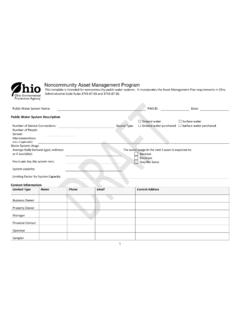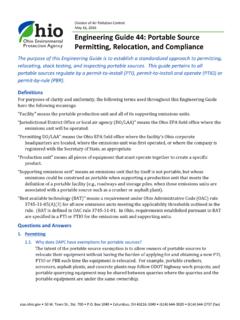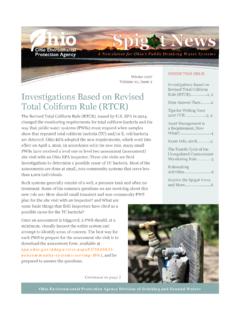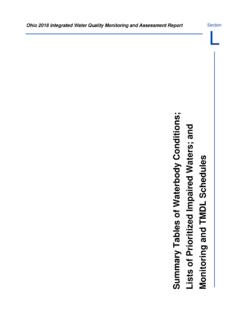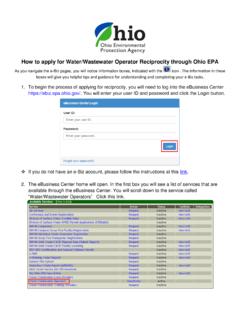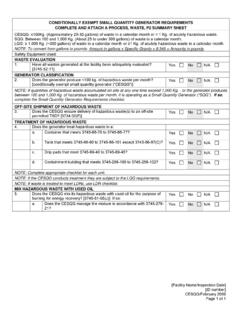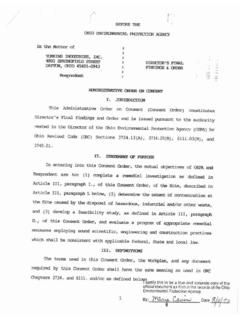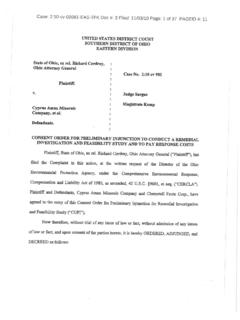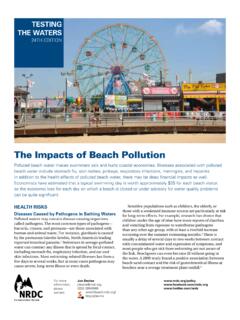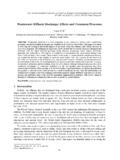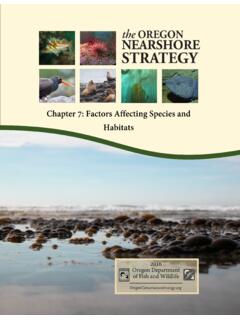Transcription of Water Pollution Control Loan Fund
1 Water Pollution Control Loan Fund PY 2022 Program Management Plan FINAL. Division of Environmental and Financial Assistance (DEFA). December 15, 2021 FINAL. TABLE OF CONTENTS. Cover photos: NEORSD Westerly Storage Tunnel (top), Nelsonville New Regional WWTP (right), WRRSP Tremper Mound Scioto River Protection (bottom). SECTION PAGE. INTRODUCTION 1. NOTEWORTHY ITEMS FOR PY 2022 2. MISSION AND GOALS OF THE WPCLF 4. WPCLF FUNDS AND PROGRAM FINANCING 5. INTEGRATED PRIORITY SYSTEM, PROJECT 8. PRIORITY LIST, INTENDED PROJECTS LIST. PRINCIPAL FORGIVENESS AND 9. INTEREST RATE DETERMINATIONS. PROGRAM ADMINISTRATION COSTS 12. DISTRIBUTION OF WPCLF FUNDS 12. MANAGEMENT ACTIONS 13. PROGRAM ADMINISTRATION CONDITIONS 16. FEDERAL ASSURANCES 18. APPENDIX A - Definitions APPENDIX B - Project Lists APPENDIX C - Ineligible Costs APPENDIX D - Interest Rates and Terms APPENDIX E - Interest Rate Discounts APPENDIX F - Planning and Design Loans APPENDIX G - Household Sewage Treatment Systems APPENDIX H - Non-Point Source Projects APPENDIX I - Storm Water Funding APPENDIX J - Principal Forgiveness APPENDIX K - Integrated Priority System APPENDIX L - WRRSP.
2 APPENDIX M - Changes Due to WRRDA. APPENDIX N - Extended Term Financing &. FAQs APPENDIX O Response to Public Comment INTRODUCTION. The Ohio Environmental Protection Agency (Ohio EPA) was created in 1972. Ohio EPA's Central Office is located in Columbus, and five district offices manage the Agency's programs throughout the state. The director of Ohio EPA is appointed by the governor and serves as a cabinet member. Ohio EPA establishes and enforces standards for air, Water , waste management and cleanup of sites contaminated with hazardous substances. We also provide financial assistance to communities, businesses, and individuals; environmental education programs; and Pollution prevention assistance to help organizations minimize waste and maintain compliance. The Division of Environmental and Financial Assistance (DEFA) administers the Water Pollution Control Loan Fund (WPCLF) program that offers low interest loans and other forms of assistance for Water resource protection and improvement projects.
3 The Program Year (PY) 2022 WPCLF Program Management Plan (PMP) describes how Ohio EPA proposes to prioritize projects, distribute funds, and administer funds. The WPCLF program year is January 1st to December 31st. Public Participation On November 2, 2021, Ohio EPA released the Draft PY 2022 WPCLF PMP for public comment. The 30- day public comment period concluded with a public hearing on December 2, 2021 at 11:00 Ohio EPA, Conference Room A (Autumn), 50 W. Town St., Columbus, OH 43215. Participants could also attend the public hearing virtually and submit comments for review. Written comments were submitted during the comment period as well as the public hearing. Responses to comments received are summarized in Appendix O. About the WPCLF. The WPCLF is a revolving fund designed to operate in perpetuity providing low interest rate loans and other forms of assistance for Water resource protection and improvement projects. In addition, specialized services, including principal forgiveness, are provided for qualifying small and hardship communities.
4 Examples of projects that can be financed through the WPCLF are: Publicly-owned wastewater treatment plant and sanitary sewer system construction, combined sewer overflow controls, sewer system rehabilitation and correction of infiltration/inflow;. Publicly-owned septage receiving facilities, septic system improvements, urban storm Water runoff, stream corridor restoration, agricultural runoff controls, source Water /wellhead protection, green wastewater and surface Water infrastructure, and other non-point source Pollution Control projects as allowed under the Clean Water Act. 1. NOTEWORTHY ITEMS OF THE PY 2022 WPCLF PMP. 1. Readiness-to-Proceed Criteria for Principal Forgiveness Beginning in PY 2019, Ohio EPA formalized a process to evaluate readiness-to-proceed as it relates to WPCLF principal forgiveness awards. The road map below illustrates a phased approach to evaluate and rank projects based on readiness-to-proceed criteria. Only projects submitted by entities eligible for principal forgiveness will be reviewed for readiness-to-proceed.
5 This is a secondary evaluation to the project score using the Integrated Priority System. A project's readiness-to-proceed ranking is identified on the project tables in Appendix B. The ranking is based on project information readily available at the time of evaluation and provided with the project nomination. To maximize the availability of principal forgiveness to as many eligible entities as possible, one principal forgiveness award will be allocated per eligible entity each program year. Additionally, principal forgiveness availability is dependent upon federal appropriations. Refer to Appendix J for additional information. 2019 2020 2021 2022. Readiness-to- Established user Established user Established user proceed publicized charge system charge system charge system Preference may be Approvable facility Approvable facility Approvable facility given to projects that plan submitted with plan submitted with plan submitted with are ready to proceed project nomination project nomination project nomination Design underway Design underway Design underway Preference will be PTI application PTI application given to projects that submitted/approved submitted/approved are ready to proceed Public participation 2.
6 Affordability Criteria and Principal Forgiveness Changes to the Clean Water Act required Ohio EPA to develop and use affordability criteria as a primary determiner in the distribution of principal forgiveness. These criteria are described in Appendix J. The maximum amount of principal forgiveness that Ohio is permitted to offer for PY 2022 is approximately $ million from the federal capitalization grant. Approximately $ million will be reserved for regionalization projects. Approximately $ million will be reserved for replacement or repair of failing household sewage treatment systems (HSTS) or for connecting abandoned HSTS to existing sewers. Up to $500,000 will be reserved to fund back-up power facilities. The remaining funds will be allocated to eligible municipal wastewater collection and treatment projects. Additionally, recaptured principal forgiveness funds may be made used for program initiatives such as HSTS or regionalization projects (refer to Item 6 for additional details).
7 A maximum of $4 million in recaptured funds is available for PY 2022. Additional grant and principal forgiveness funds may become available during PY 2022 ( USEPA. grants, H2 Ohio Funds, COVID-19 related stimulus funding, etc.) and will be directed toward the three focus areas described above. Projects listed in Appendix B will be evaluated throughout the program 2. year as additional funds become available to determine suitability for funding. Readiness-to-proceed will a main determiner in awarding funds. Refer to Item 1 above and Appendix J for more information. 3. Regionalization Discount For PY 2022, Ohio EPA is making $50 million in discounted loans available at a 0% interest rate for regionalization projects. Regionalization is defined as independent entities working together to share the responsibility of providing services to their residential, commercial, and industrial customers by physically connecting their sewage collection systems or by using a centralized wastewater treatment system.
8 (See Appendix E for additional information). 4. Nutrient Reduction Discount (NRD). In response to harmful algal blooms (HABs), Ohio EPA is offering $50 million at a 0% interest rate for these types of projects. The discounted rate will be available for the portion of the project directly attributed to the nutrient reduction. Standard, below-market interest rate loan funds will be offered for the balance of a proposed project (See Appendix E). NRD project nominations are accepted throughout the program year. 5. Available Funds As of October 26, 2021, the total available funds for PY 2022 are estimated to be $ billion. To meet the demand for assistance during PY 2022 and beyond, Ohio EPA intends to borrow against the WPCLF's loan repayments by issuing revenue bonds or notes. The total requested amount on the Intended Projects List (IPL) is over $2 billion, although the actual amount which will be awarded will be based on readiness-to-proceed. Ohio EPA intends to fund all eligible projects that are ready to proceed in the upcoming program year.
9 6. Water Resource Restoration Sponsor Program (WRRSP) Funding for PY 2022- PY 2023. For PY 2022 PY 2023, Ohio EPA is allocating $15 million to the WRRSP for protection and restoration as well as Urban Corridor Dam Restoration (UCD-Restoration). Beginning with PY 2020, the UCD- Restoration category was announced as a new subset of the larger WRRSP Restoration category. UCD- Restoration project attributes include a collaborative effort between communities to remove multiple dams within their collective urban corridor. Additionally, these projects will be part of a larger planned revitalization effort for restoration of important waterways, while achieving both ecological and Water quality benefits. Please refer to Appendix L for additional WRRSP programmatic information. Appendix B. includes a list of projects within fundable range. 7. Loans for Planning Activities and Design Projects All planning and design loans with terms of five years or less will receive a 0% interest rate.
10 Furthermore, planning and design nominations will be accepted throughout the program year as part of an open cycle. For communities eligible to receive principal forgiveness, planning and design loan costs may be rolled into the project construction loan. 3. 8. Household Sewage Treatment System Repair/Replacement Updates Beginning in PY2023, Ohio EPA may review the past performance of previous and/or current grantees when allocating principal forgiveness awards. Past performance review may include, but is not limited to, evaluating use of funds ( , total disbursements from previous grant awards, outstanding balances on current awards, etc.), compliance with program requirements and capacity to manage additional awards. This effort will help ensure principal forgiveness funding is fully utilized each program year. 9. Principal Forgiveness for Back-up Power In PY 2022, Ohio EPA will make up to $50,000 of principal forgiveness available per project for the procurement and installation of back-up power for wastewater treatment facilities.

